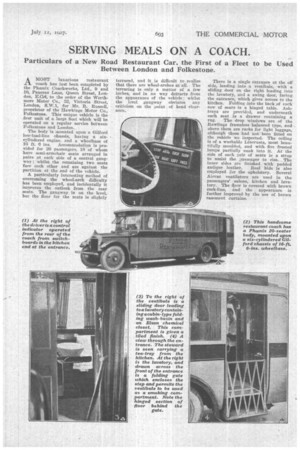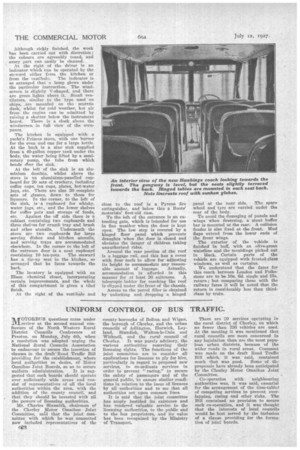SERVING MEALS ON A COACH.
Page 49

Page 50

If you've noticed an error in this article please click here to report it so we can fix it.
Particulars of a New Road Restaurant Car. the First of a Fleet to be Used Between London and Folkestone.
AMOST luxurious restaurant coach has lust been completed by the Pheenix Coachworks, Ltd., 9 and 10, Pancras Lane, Queen Street, London, E.Cet to the order of the Worthmore Motor Co., i32, Victoria Street, London, S.W.1, for Mr. R. Russell, proprietor of the Hawkinge Motor Co., Folkestone. This unique vehicle is the that unit of a large fleet which will be operated on a regular service between Folkestone and London.
The body is mounted upon a Gifford low-load-line chassis, having a sixcylindered engine, and a wheelbase of 1(3 ft. 6 ins. Accommodation is provided for 20 passengers, 18 of whom have semi-armchair seats arranged in pairs at each side of a central gangway: whilst the remaining two seats face each other and are against the partition at the end of the vehicle.
A particularly interesting method of overcoming the wheel-arch difficulty has been employed, and incidentally it improves the outlook from the rear seats. The gangway is on the level, but the floor for the seats is slightly terraced, and it is difficult to realize that there are wheel-arches at ail. The terracing is only a matter of a few inches, and in no way detracts from the appearance of the vehicle: whilst the level gangway obviates any criticism on the point of head clearance.
There is a single entrance at the -off side, leading into a vestibule, with a sliding door on the right leading into the lavatory, and a swing door, facing the entrance, which gives access to the kitchen. Folding into the back ,of each row of seats is a hinged table. Ashtrays are provided, and underneath each seat is a drawer containing a rug. The drop windows are of the Rawlings frameless balanced type, and , above them are racks for light luggage, although these had not been fitted on the vehicle we inspected. The ceiling is of a washable Lincrusta, most beautifully moulded, and with five frosted lamps partially sunk into it. At the side of each pair of seats is a strap to assist the passenger to rise. _ The inner sides are finished with padded
antique leather. Real hide is also employed for the upholstery. Several Airvac ventilators' are used in the passengers' saloon, kitchen and lavatory. The floor is covered with brown cork-lino, and the appearance is further improved by the use of brown casement curtains. Although richly finished, the work has been carried out with discretion ; the colours are agreeably toned, and every part can easily be cleaned.
At the right of the driver is an indicator which can be operated by the steward either from the kitchen or from the vestibule. The indicator is so arranged that a lamp glows under the particular instruction. The windscreen is slightly V-shaped, and there are green lights above it. 501511 ventilators, similar to the type used on ships, are mounted on the scutttle dash, whilst for cold weather, hot air from the engine can be admitted by raising a shutter below the instrument board. There is a dock above the windscreen in full view of the occupants.
The kitchen is equipped with a yacht's Primus stove, with one burner for the oven and one for a large kettle. At the back is a zinc sink supplied from a 40-gallon copper tank under the body, the water being lifted by a semirotary pump, the tube from which bends ciVer the sink.
At the left of the sink is an aluminium dustbin, whilst above the stove is an aluminium-panelled cupboard for 20 sets of crockery, including coffee cups, tea cups, plates, hot-water jugs, etc. There are also 20 complete sets of glasses, down to those for liqueurs. In the corner, to the left of the sink, is a cupboard for whisky, water jugs, etc., and the lower shelves for coffee pots and storage of foods, etc. Against the off side there is a cabinet containing two cupboards and three shelves for crumb tray and brush and other utensils. Underneath the stove are two cupboards for large serving dishes and kitchen utensils, and serving trays are accommodated elsewhere. In the corner to the left of the entrance door is a neat cupboard containing 10 tea-pots. The steward has a tip-up seat in the kitchen, so arranged that he faces towards the back.
The lavatory is equipped with an Bison chemical closet, incorporating certain improvements, and the whole of this compartment is given a tiled finish.
At the right of the vestibule and close to the roof is a Pyrene fire extinguisher, and below this a Boots' motorists' first-aid ease.
To the left of the entrance is an extending gate, which is intended for use in fine weather when the door is kept open. The low step is covered by a hinged floor panel which prevents draughts when the door is dosed and obviates the danger of children taking unauthorized rides.
Around the rear portion of the roof is a luggage rail, and this has a cover with four reefs to allow for adjusting its height to accommodate any reason able amount of luggage. Actually, accommodation is afforded in this manner for at least 20 suitcases. A telescopic ladder for reaching the roof is clipped under the front of the chassis.
Access to the petrol filler is obtained by unlocking and dropping a hinged panel at the near side. The spare wheel and tyre are carried under the rear of the body. .
To avoid the damaging of panels and wings when ieuersing, a stout buffer bar is mounted at the rear. A collision fender is also fixed at the front. Mud flaps extend from the lower ends of the front wings.
The exterior of the vehicle is finished in huff, with an olive-green waistline and the mouldings picked out in black. Certain parts of the vehicle are equipped with frosted-glass windows, as well as curtains.
We understand that the fares for this coach between London and Folkestone are to be 1Gs. 6d. single and 15s. return ; but comparing these with the railway fares it will be noted that the return is considerably less than thirdclass by train.












































































































